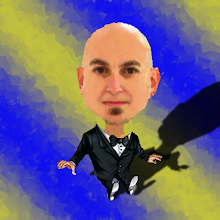Art History My Way
I've been lax around these parts lately, doing most of my small posts on Tumblr instead of here. It's a simpler, cleaner, quicker interface for short-form posts and other than sketches and TV reviews, that's mostly what I've been cranking out lately. Really short pieces, barely longer than what I might Tweet. If y'all aren't already following me over there, you should - either through Tumblr's follow mechanism if you've got an account or through the RSS feed.
But anyway...
I've been doing this series of pieces that I think are worth reposting here, so below are the first three. Hope you enjoy.
Mondrian was the most accomplished artist of the group, but the contributions of his children should not be overlooked. His youngest daughter Tracy for example, while possessing none of the skills of her father or older siblings, was quite adept at stretching canvases and skins, even pioneering a technique for stretching animal skins across a ring-shaped frame called a tambourine. The eldest child, Keith Mondrian, eventually became a bigger draw than his famous father as young women flocked to see him paint in tight pants.
The Mondrians toured successfully for four years thanks to the shrewd decisions of Kincaid and middle child, Danny. Danny Mondrian’s later problems due to his violent temper and sexual proclivities have been attributed by many to his atypical teen-aged years, but no one can question the quality of art he produced during that period.
—Laurence Funderkirk, The Modern Dutch Masters (Weehawken: Bergen County Community College Press, 1997), 212.
The tempestuous heiress brooked no quarter, destroying the futures of dozens of promising artists for no more than expressing sympathy for Ernst. However, for confidants such as Miró, Guggenheim showed even less mercy.
Blacklisted, the Spaniard was unable to find work through the 1940s and ’50s. Not until the mid ’60s did he finally secure a position working on background cels for Hanna-Barbera. While he worked under a pseudonym, astute observers on Guggenheim’s payroll did eventually spot his signature on a single frame and brought it to her attention in the autumn of 1971.
—Emily Rothschild-Messerschmitt, The Story of Miró (Batemans Bay, NSW: Eurobodalla Adult Education Centre Press, 1983), 669.
The Garden was recently on loan to the William Maxwell Gaines Gallery in midtown where Jaffee is employed as the chief archivist. He examined the panels under the gallery’s electron microscope and discovered evidence that a message was cleverly hidden, only visible when folded shut in the appropriate configuration.
“Without the missing panels, I couldn’t say what Bosch’s message was,” Jaffee said. “It’s enough to drive me mad.”
Even if Jaffee can deduce the missing message on the back of the panels, the larger question remains as to what graced their fronts.
“Knowing those panels are out there means we might be able to find them someday,” Jaffee mused over lukewarm coffee in his office. “I hope whatever’s to the right of hell is really raunchy.”
—A. E. Neuman, “Five Wooden Panels,” New York Times, May 7, 2009, Arts section.



